The latest version of a multistate plan to lower transportation emissions represents an improvement, but still doesn't go far enough on environmental-justice issues, some advocates say.
The Transportation Climate Initiative Program's new iteration, released on June 10, lacks the full protections that low-income, Black and brown communities deserve after years of environmental neglect, in some advocates' view. Still, it does provide a path forward to help such communities, in the view of others.
The initiative will start charging gasoline and diesel fuel suppliers fees for their climate pollution by 2023.
The revision contains more input from underserved and overburdened communities and provisions to create living-wage jobs and so is “mainly good news,” said Eleanor Fort, deputy director of Green for All. “States were really listening to feedback and have figured out a way” to strengthen equity provisions, Fort said.
But Basav Sen, climate policy project director at the Institute for Policy Studies, called the improvements “symbolic gestures,” and said that “the end result does not reflect the comments that they did get.”
The disagreement is over whether market mechanisms such as cap-and-trade system really can reduce climate emissions and air pollution and whether the local equity-advisory bodies the program creates will have enough power to protect vulnerable communities.
The latest version of the plan comes after years of exhaustive negotiations among states and input from stakeholders, and includes the final model rule that will guide governments on implementing the program. Massachusetts, Connecticut, Rhode Island, and Washington, D.C., have signed on. Eight other states remain "at the table and actively engaged,” said Peter Rafle, communications director of the Georgetown Climate Center, which has worked closely with states in crafting the program.
The initiative is projected to provide $290 million each year in health and safety benefits for the three states, and the District, by reducing premature deaths, asthma symptoms, and traffic-related injuries.
Still, many environmental-justice groups question whether a free-market-based plan will work. The pact allows companies to pay for the right to pollute, auctioning off credits for transportation fuel and using the funds raised to provide cleaner options, such as infrastructure for electric vehicles, more and better public transit, and better walking and biking infrastructure.
Sen described cap-and-trade as “a policy that regulates emissions after the fact, rather than address the root causes," which is a goal of the proposed Green New Deal, which would place a hard limit on emissions. For Sen and his like, cap-and-trade “creates the wrong incentives” and leads to loopholes. For instance, “polluters buy up the permits when it’s cheap even when they know they’re not going to use them, because they can sell them later.”
For Fort, however, “the key is in, not whether or not a market is created, but how that market is created. Policy shapes markets all the time.” She added that “right now polluters get to pollute for free. ... The cost for their pollution gets passed on to people in the form of climate disasters, health impacts, etc. So making them pay for that pollution is a way to force the market to address that externality.” Even under the regulatory system favored by many environmental-justice advocates, polluters may still evade enforcement and pay fines rather than comply with the law.
Sen pointed to deficiencies in earlier cap-and-trade programs, which may lower emissions across a large geographical area but provide little or no benefit to the most neglected neighborhoods. He cited California’s long-standing a cap-and-trade program, which has tended to benefit more-affluent communities. Even with (or perhaps because of) cap-and-trade, polluting facilities are “more likely to be located in communities with higher proportions of residents of color and residents living in poverty,” a 2016 study concluded.
Others say that cap-and-trade works. The Georgetown Climate Center pointed to research finding that, from 2012 to 2017, California's cap-and-trade program lowered pollution exposure for disadvantaged communities by 21 percent to 30 percent. Moreover, since 2017, California has expanded its cap-and-trade program to include projects focused on community air protection for disadvantaged communities.
Notably, the initiative now mandates that at least 35 percent of funds raised by the program go toward disadvantaged communities — and specifies it as a floor, not a ceiling. For instance, proposed legislation in Connecticut would mandate that 50 percent of program funds go to such communities.
Moreover, provisions in the Transportation Climate Initiative on the local equity-advisory committees say that more than half the members of each board must be from the affected community and “make sure that benefits from investments are really going to those communities,” said Fort.
Still, the equity-advisory committees have no real legal authority. “The model rule is at best a strong suggestion," Sen said. "Ultimately, it is up to states to write their implementing legislation and their implementing regulations, and they can choose to ignore or water down what’s in the model rule.” A governor or state legislature couldn decide to apply funds raised from the program to pet projects.
Fort agrees that activist groups must watch governments closely, but she said that the latest version puts these watchdog groups in a solid position, because it includes language spelling out legitimate uses for such funds.
The newest version of TCI-P also clearly spells out local air-quality monitoring rules and places monitoring stations next to highway running through underserved neighborhoods so that air can be “continuously monitored during high-traffic times of day,” said Fort. The equity-advisory groups will have a strong say in where monitoring occurs and will receive technical assistance.
Air-quality monitoring by itself will not ensure cleaner air, but will make the job of local activists and watchdog groups easier. They will have immediate, accurate information on, for instance, diesel trucks passing through a neighborhood to a port. Should the TCI-P work as planned, such diesel trucks will be replaced, over the years, with a clean fleet, clearing the air in neighborhoods that need it most.
Finally, the new version includes job training in such neighborhoods, supports unionization and encourages the hiring of former felons — crucial issues for social-justice groups.
In all, officials feel hopeful the initiative will lower climate emissions while cleaning the air in disadvantaged communities. “I’m really happy for the states, because they’ve been working toward this for a long time,” said James Bradbury, the Georgetown Center's mitigation program director.






